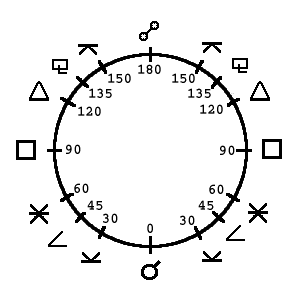 When you hear, “Venus is in aspect to Mars” this means there is a mathematical connection between the two planets. We’re talking about standard geometry here. A 90 degree angle is a “square”, a 180 degree angle is an “opposition”… etc.
When you hear, “Venus is in aspect to Mars” this means there is a mathematical connection between the two planets. We’re talking about standard geometry here. A 90 degree angle is a “square”, a 180 degree angle is an “opposition”… etc.
You can see cheat sheet on aspect here. I urge beginners to focus on the Major aspects first (Conjunction, opposition, trine, square, sextile… plus the inconjunct or quincunx (terms which are interchangeable). From here, we think!
If I am Tammy and I see Tom across room, I note him.
If he comes walking towards me I will feel his energy stronger. The closer he comes the more intense my response or reaction. This is for good or ill depending on what kind of man Tom is.
When Tom is standing right next to me I’ll surely be crackling. If he’s right on top me there may be a point where I am completely merged with Tom. The planets work the same way.
Using the conjunction aspect as an example if someone has Pluto at 2 Virgo 13 (read “Two degrees, thirteen minutes of Virgo:) and Mercury at 2 Virgo 13, that would be an exact conjunction (inordinately rare).
If someone had Pluto at 2 Virgo 13 and Mercury at 2 Virgo 47 this would also be called and “exact conjunction”.
The minutes are insignificant. The guy is all the way on top you and if his toe is not touching you it doesn’t make that much difference does it? If the aspect is 1-3 degrees off that would be considered a “tight conjunction” by most. The number of degrees that separate the aspect are called the “orb” so if Pluto is at 2 Virgo and Mars is at 6 Virgo that is a conjunction with a 4 degree orb.
The tighter the orb the more intense the play between the two planets but it common for astrologers to designate a certain number of degrees for the various aspects and if the orb is wider than the number designated they no longer consider the planets to be in aspect / relationship.
You don’t have to worry about a lot of this stuff because the computer programs list the aspects according to whatever defaults have been set but here are common perimeters:
-Any aspect that involves the Sun and Moon 8-10 degrees
-Squares, oppositions and trines 6-8 degrees
-Sextiles, inconjuncts 3-5 degrees
Personally, I prefer tight orbs; the low end of what is above. But this is because if you open them up you have lines drawn all over the place and I don’t like clutter. I want to see what is most prominent in a chart but when I look at a chart like this, I do mind reality which is:
There are 360 degrees in a circle. If you look in the sky and you see two planets close together there is no doubt they are exchanging energy. Even if you’ve got planets in a sign that are 15 degrees apart there is still some crackle going on. These things just don’t fall off a cliff if there are 10 degrees plus 1 minute separating. It is not likely a conjunction with an orb that large is going to dominate the chart but make no mistake, there is some kind of relationship there.
The thing to do then, is filter the information because here’s a fact: Most people know very little about themselves. They rarely understand much more than the tip of their own iceberg so if you send them off to go look at all this minutiae they are going to get wrapped around the axle for sure. So I want to mention this all this but strongly suggest you focus on what is most prominent and in your face in your chart and come to understand it pretty well before you start running off to the circus and completely lose the plot. Because I see this all the time:
People can tell you all about their blah, blah, blah minor aspect with a fixed star that is progressed but the fact their heart is hemorrhaging right in the middle of their body escapes them completely. Do you think that is good astrology? I think it’s ridiculous astrology. So please, please deal with the things in your chart that beg to be dealt with before running off looking for distraction otherwise distraction is all you’re going to get.
I like to compare astrology to painting and there two points to make here on that front. One, you get the color blocked and large brushstrokes down first before you come in with the fine brush to add detail. Secondly, regarding the orbs, in good paintings there are no hard edges. People don’t have hard edges either do they?
So set your orbs, I recommend they be tight but don’t ever forget people communicate across a room all the time. Meantime pay attention to the people around you and specifically how you feel when they are near. Realize that your experience of them would be shown (blatantly) if you compared the two charts which you have to admit is pretty damned cool.
Studying astrology? Check out our Astrology Beginner’s Package.


Thanks!
This is great stuff.
thanks, elsa! it’s always the math that put me off more deeply pursuing astrology. i appreciate the clarification in bite-sized chunks. if i hadn’t been around here, i never would have picked up as much as i have. ’cause you talk in stories and i get those… 🙂
yeah, i always felt a bit iffy about those cluttered charts with the really wide orbs. but maybe that’s my excuse to avoid going around saying i have a saturn/moon opposition giving me a grand cross 😉 all those hard aspects to my moon barely make it across the finish line ahead of the ten degree mark…
anyway, astrodienst uses _really_ wide orbs. i wonder if i can adjust those?
Speaking of astro.com – I have my own software and never go there but I meant to ask if there is someone out there who is familiar with what if offers and who can write up something for the beginner… I would sure appreciate it. Beginners guide to using astro.com com?
If someone will do this, I will post it as a separate blog and I am sure it will help a lot of people.
Wyrdling . . You can adjust the orbs on astrodienist under options (when you are in the extended chart selection section/option scroll down the page)
yup, you can. atabout 90% they look better.
but, apparently, i still have moon trine pluto? saywhat (i still get these duh! moments after looking at this chart since i was 12… but the one my cousin made for me used the same orbs for everything including the luminaries.)
So much of this seems to be what IS obvious. No astrology needed. Like if you tell me I’ll amass more wealth by getting a 9-5 well I already know that’s a possibility but it isn’t going to happen because it would make me unhappy in other ways. I’m looking for pearls.
Wait! I was told there’d be no math involved . . . . (har-har 😉 )
Persoanlly, I think some people do have hard edges.
^ *Personally. Nice typo.
SkyPie – interesting comment, so I wrote another blog… 🙂
This is great! Oppositions are tough for me to understand, I don’t know why!
I am looking forward to finding out about Quintiles (if you do teach about them) They boggle my mind…in one of my synastry charts, I have a sun quintile sun but it’s aries and cancer.
So is it square with a good aspect? Is it good? Is it quintile and no square at all? hahaha novice for sure 😉
I don’t use minor aspects because there is plenty of stuff to take up all the time with just looking at the basics.
Wow, Elsa, you are putting a lot of work into this free class/training. I hope people are remembering to tip! We always remember to tip the bartender, but this is something even better then being handed the wine, it is like being handed the grapes and an instruction sheet!
Can you explain (pretty please) the meaning or manifestation of a sesquiquadrate? I could never quite could understand those.
The big issues in my chart:
– T Square Pluto/Saturn/Moon
– T Square Mercury/Mars/Uranus
– T Square Mercury/Jupiter/Mars
Yay me…! -_0
I tend to give more attention to the Pl/Sat/moon one…
Wow this is great. Thanks, Elsa!
So glad you said this , I dont like clutter in a chart also. large clear colour, with houses on outside of wheel , thats what i like.
“Her point was that even if you’ve got planets in a sign that are 15 degrees apart there is still some crackle going on.”
Hmmm! SO interesting. Thanks for this re-post, it’s good getting refreshed. I have Sun 10 degrees from my Mercury and have always wondered about it being conjunct.
I use very small orbs, but I see I’m not the only one. My chart has lines all over the fecking place even with small orbs.
15 degree’s way out for a conjunction from sun to mercury, gota draw line somewhere.
This is awesome. Thanks for reposting!
Thanks Elsa, great blog. You rock! 🙂
Welcome and thanks, Windswept. 🙂
Thanks, kr. 🙂
Great post!
i love this post!
…..and thanks for the chart of aspects. Very helpful to a visual type like myself. Made myself a copy.
Some lovely images to help simplify the language of astrology. Thank you for your insightful post.
best, Sally
Need to put order into my orbs. They make me question a lot. Is applying pluto conjunct midheaven at 10 deg too wide? Why do some sites completely obliterate my mars square moon and neptune at 7 degrees (even square uranus at 6!) because that’s not that wide? And it would be great to not have those aspects, but if they are there, then there’s that. Orbs and different astro programs uniting to make me feel distressed because they all give different results. Would love to if somebody would post more or less their guide to orbs, how much for a square,conjunction, trine,etc how much for luminaries, angles, the rest of the planets, etc. also the big 5 asteroids orbs would be nice. 🙂
Reading this again and saw there are guidelines to orbs in this post by Elsa and they were very helpful. It goes with my beliefs as well. Mars squares at 7 degrees have an impact despite what other astro programs show. Also I never have considered my venus and jupiter trine ascendant at 9 respectively at 10 degrees. That’s a really wide orb for trines and I wonder why astro . com would really note them down.